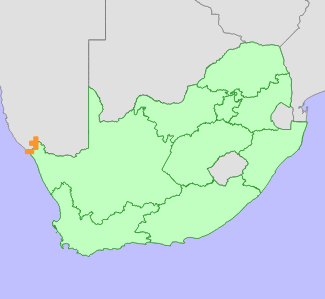|
Scientific Name | Crassula sladenii Schönland |
Higher Classification | Dicotyledons |
Family | CRASSULACEAE |
National Status |
Status and Criteria | Endangered A2a |
Assessment Date | 2015/05/14 |
Assessor(s) | D. Raimondo, P.M. Burgoyne, L. von Staden & P.C.V. Van Wyk |
Justification | A population reduction of at least 50% is estimated based on field observations of population decline over the past 10 years. This species has a limited distribution range in South Africa and Namibia (EOO 2445 km²), and continues to decline across its range due to ongoing habitat loss and degradation. |
Distribution |
Endemism | Not endemic to South Africa |
Provincial distribution | Northern Cape |
Range | Southern Namibia and the Richtersveld around the lower Gariep Valley. |
Habitat and Ecology |
Major system | Terrestrial |
Major habitats | Western Gariep Hills Desert, Western Gariep Lowland Desert, Western Gariep Plains Desert, Noms Mountain Desert |
Description | Rocky slopes. |
Threats |
| This species is threatened by ongoing habitat loss to mining around Sendelingsdrif and Alexander Bay, as well as along the Gariep Valley in Namibia. In some places, such as Grootderm, sand blown from exposed mine dumps are burying low-growing plants. On Helskloof, around Grootderm and Cornellskop, plants are dying out, apparently as a result of reduced nurse-shrub cover due to severe overgrazing and trampling. This species is quite likely dependent on shade provided by larger shrubs, and are dying as a result of exposure to direct sunlight and increasing soil-surface temperatures. |
Population |
Field monitoring recorded declines of more than 80% in some subpopulations (P.M. Burgoyne pers. obs.). Plants appear to be dying across this species' range in the Richtersveld (P.C.V. van Wyk pers. obs.), but the reasons are not clear. It is possibly due to disease, climate change, a loss of shrub cover due to overgrazing and trampling, or a combination of these factors. Declines are recent, within the last 10 years, in places where plants were formerly healthy and abundant. This species has a limited distribution in Namibia as well, and it is threatened in places by habitat loss. Generation length is not known.
|
Population trend | Decreasing |
Assessment History |
Taxon assessed |
Status and Criteria |
Citation/Red List version | | Crassula sladenii Schönland | EN A2a | 2015.1 | | Crassula sladenii Schönland | NT B1ab(v) | Raimondo et al. (2009) | | Crassula sladenii Schönland | Rare | Hilton-Taylor (1996) | |
Bibliography |
Hilton-Taylor, C. 1996. Red data list of southern African plants. Strelitzia 4. South African National Botanical Institute, Pretoria.
Raimondo, D., von Staden, L., Foden, W., Victor, J.E., Helme, N.A., Turner, R.C., Kamundi, D.A. and Manyama, P.A. 2009. Red List of South African Plants. Strelitzia 25. South African National Biodiversity Institute, Pretoria.
Snijman, D.A. 2013. Plants of the Greater Cape Floristic Region 2: The extra Cape flora. Strelitzia 30. South African National Biodiversity Institute, Pretoria.
Tölken, H.R. 1977. A revision of the genus Crassula in Southern Africa. Contributions from the Bolus Herbarium 8(1&2):1-595.
Tölken, H.R. 1985. Crassulaceae. In: O.A. Leistner (ed). Flora of southern Africa 14,1:1-244. Botanical Research Institute, Pretoria.
|
Citation |
| Raimondo, D., Burgoyne, P.M., von Staden, L. & Van Wyk, P.C.V. 2015. Crassula sladenii Schönland. National Assessment: Red List of South African Plants version 2024.1. Accessed on 2025/11/19 |
 Comment on this assessment
Comment on this assessment


